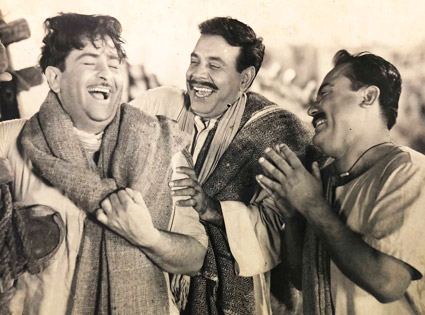
Cinema in our country has always been considered the most popular means of entertainment, having an incredible power to influence the masses. The screen icons are often invited to join political parties for the same reason, and the medium is regularly used to spread awareness about social welfare programs and state promotional campaigns run by the government.
However, we still haven’t started considering Cinema as an important representative of our rich cultural heritage or a significant part of our basic education, introducing the medium to the youngsters as a powerful means to express themselves and their ideas. Films have rarely been used to make the young students familiar with our extensive Indian literature written in various regional languages, and the exposure has always been limited to a couple of screenings in a year as a mandatory extra-curricular activity in schools.
That is the reason I got pleasantly surprised to find a complete chapter on a film, in the Hindi textbook of class 10th - Sparsh (Part 2) - published by National Council of Educational Research and Training (NCERT). Written by Prahlad Agarwal, the chapter has been titled “Teesri Kasam Ke Shilpkar Shailendra” (Shailendra–the sculptor of Teesri Kasam), conveying all about the classic (directed by Basu Bhattacharya) in its four-page text along with a detailed set of questions for the students.
As a well-prepared educational document, it begins with the mention of Raj Kapoor and his Mera Naam Joker that was being made when Teesri Kasam got released. Praising Raj and Waheeda Rehman’s realistic portrayal and performance, the writer quotes the film as ‘a painting on celluloid’ winning the President Gold Medal and many other reputed awards for its exceptionally executed content and music.
Incorporating many interesting anecdotal references to engage the young students, the chapter duly informs them about the classic storyl “Marey Gaye Gulfam” by Phanishwar Nath Renu – the film is based upon and how Raj Kapoor agreed to do the experimental project as a dear friend of Shailendra giving him a pleasant surprise. But along with the praises, it also makes them aware of the reality of the film’s failure at the box office and how it struggled to get even decent distributors releasing the film in the major cities.
The chapter becomes even more important in educating young students about Indian cinema and its music, recounting songs in the film based on the local language and traditional folk music of the region. Giving information about the most famous ones (along with a few dialogues), it thankfully also mentions “Laali Laali Doliya Mein Laali Re Dulhaniya” which questionably remains the lesser-talked-about song from the film’s outstanding soundtrack.
Interestingly, there are more references added into the text related to Shailendra as a visionary lyricist/poet showcasing his vast knowledge in the lyrics of songs like “Pyar Hua Ikraar Hua” from Shree 420. Elaborating on the same, the writer mentions how once a particular line of the song created confusion among Shailendra and Shankar-Jaikishan, who wanted to get it changed, making it simpler. The line was “Ratein Dason Dishayon Se Kahengi Apni Kahaniyan”. The music director duo doubted the listeners would not be able to understand ‘Das Dishayen’ (10 directions) as we normally refer to only four. But they eventually went with the same when Shailendra silently informed them about all the ten directions.
Though the writer doesn’t explain that in the textbook chapter, recently Dinesh Shankar (Shailendra’s son) beautifully described the incident in one of his Facebook posts. In Dinesh’s words, “As Shailendra insisted he was right, Raj Kapoor chipped in and explained that they also count the intermediates between the four major directions. To this everyone agreed, but then it still made only eight. At that moment, they all looked towards the poet who kept smiling puffing his cigarette. Without saying a word, he then pointed towards the sky and the ground below. The argument had ended and Raj Kapoor hugged Shailendra, his Kaviraj, who had not let him down.”
The chapter truly excels with such educating references and it continues doing so in its exercise section too, asking students to read the original novel and write their review of the film, making all the important references. In the same set of questions, it also asks them to find more Hindi films based on the works of famous authors representing our Indian literature and more songs that have their origin in our rich Indian traditional folk music.
Unfortunately, the chapter on Teesri Kasam has been deleted from the course this year, as per the changes made in the syllabus because of Covid-19. But we certainly need many more chapters like these in the school textbooks, educating youngsters about Cinema, recognizing the medium as a respectable part of the cultural heritage of India.
Cheers!
Bobby Sing
bobbytalkscinema.com
NOTE : The article was first published in THE FREE PRESS JOURNAL Newspaper (Mumbai Edition) on 14th March 2021.
Note : The write-up is a chapter shared from my upcoming book releasing soon. So any additions, rectifications suggested by friends are welcome to make it better.
----------
 For more such interesting articles on lesser known facts on Hindi Cinema, do try DID YOU KNOW
For more such interesting articles on lesser known facts on Hindi Cinema, do try DID YOU KNOW Series by
Bobby Sing available in both
Book and
E-book form
.
Also available
at Notionpress and Flipkart stores (in India)
The book is now also available in Hindi titled ITNA TO YAAD HAI MUJHE published by Prabhat Prakashan
Available at all leading portals online.


 For more such interesting articles on lesser known facts on Hindi Cinema, do try DID YOU KNOW Series by Bobby Sing available in both Book and E-book form.
For more such interesting articles on lesser known facts on Hindi Cinema, do try DID YOU KNOW Series by Bobby Sing available in both Book and E-book form.